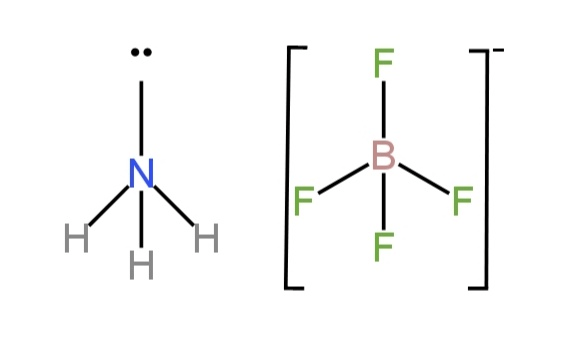
In which of the following species the interatomic bond angle is \[109^\circ 28\prime \;\].
A.\[N{H_3},{\rm{ }}{\left( {B{F_4}} \right)^{ - 1}}\;\]
B.\[{\left( {N{H_4}} \right)^ + },{\rm{ }}B{F_3}\]
C.\[N{H_3},{\rm{ }}B{F_4}\]
D.\[{\left( {N{H_2}} \right)^{ - 1}},{\rm{ }}B{F_3}\]
Answer
225k+ views
Hint: Bond angle 109°28′
is demonstrated by a regular tetrahedral molecular geometry.
When the central metal atom having a tetrahedral shape has 4 bond pairs and no lone pairs, it will demonstrate this bond angle.
Complete step by step solution:The angle between two bonds arising from the same atom in a covalent species is comprehended as the bond angle.
The given bond angle is in species with regular tetrahedral geometry and they carry a hybridization of\[s{p^3}\].
For this, the steric number is 4. The steric number is the no.of atoms, groups, or lone pairs for the central metal atom.
For the given bond angle, there are generally 4 bonding pairs of electrons and no lone pairs.
So currently we have to study the provided molecules and attempt to find out the number of bond pairs in them.
Out of the given options, \[N{H_3},{\rm{ }}{\left( {B{F_4}} \right)^{ - 1}}\;\]both have interatomic bond angles of \[109^\circ 28\prime \;\].
\[N{H_3}\;\]
There is an N atom which is the central atom. It has 5 valence electrons.
Three electrons undergo bond formation with each of the three hydrogen atoms and the rest lone pair of electrons is there.
So, there are three bond pairs and one lone pair.
So, it has a pyramidal structure due to the repulsion between bond pairs and the lone pair.
So, the bond angle is \[109^\circ 28\prime \;\].
\[{\left( {B{F_4}} \right)^{ - 1}}\;\]
The shape is tetrahedral and, in the molecule, there are four bond pairs and zero lone pairs.
There are four B-F bonds.
So, the bond angle is \[109^\circ 28\prime \;\].

Image: Structure of \[N{H_3},{\rm{ }}{\left( {B{F_4}} \right)^{ - 1}}\;\]
So, option A is correct.
Note: Ammonia is one of the central components in a ton of household cleaning products.
It is utilized as a cleaning agent and can be utilized to peel off stains from mirrors, tubs, sinks, windows, and more. Some other benefits are antimicrobial agents or antiseptics, and ammonia is also utilized as a fuel.
is demonstrated by a regular tetrahedral molecular geometry.
When the central metal atom having a tetrahedral shape has 4 bond pairs and no lone pairs, it will demonstrate this bond angle.
Complete step by step solution:The angle between two bonds arising from the same atom in a covalent species is comprehended as the bond angle.
The given bond angle is in species with regular tetrahedral geometry and they carry a hybridization of\[s{p^3}\].
For this, the steric number is 4. The steric number is the no.of atoms, groups, or lone pairs for the central metal atom.
For the given bond angle, there are generally 4 bonding pairs of electrons and no lone pairs.
So currently we have to study the provided molecules and attempt to find out the number of bond pairs in them.
Out of the given options, \[N{H_3},{\rm{ }}{\left( {B{F_4}} \right)^{ - 1}}\;\]both have interatomic bond angles of \[109^\circ 28\prime \;\].
\[N{H_3}\;\]
There is an N atom which is the central atom. It has 5 valence electrons.
Three electrons undergo bond formation with each of the three hydrogen atoms and the rest lone pair of electrons is there.
So, there are three bond pairs and one lone pair.
So, it has a pyramidal structure due to the repulsion between bond pairs and the lone pair.
So, the bond angle is \[109^\circ 28\prime \;\].
\[{\left( {B{F_4}} \right)^{ - 1}}\;\]
The shape is tetrahedral and, in the molecule, there are four bond pairs and zero lone pairs.
There are four B-F bonds.
So, the bond angle is \[109^\circ 28\prime \;\].

Image: Structure of \[N{H_3},{\rm{ }}{\left( {B{F_4}} \right)^{ - 1}}\;\]
So, option A is correct.
Note: Ammonia is one of the central components in a ton of household cleaning products.
It is utilized as a cleaning agent and can be utilized to peel off stains from mirrors, tubs, sinks, windows, and more. Some other benefits are antimicrobial agents or antiseptics, and ammonia is also utilized as a fuel.
Recently Updated Pages
JEE Main 2026 Session 1 Correction Window Started: Check Dates, Edit Link & Fees

JEE Isolation, Preparation and Properties of Non-metals Important Concepts and Tips for Exam Preparation

Isoelectronic Definition in Chemistry: Meaning, Examples & Trends

Ionisation Energy and Ionisation Potential Explained

Iodoform Reactions - Important Concepts and Tips for JEE

Introduction to Dimensions: Understanding the Basics

Trending doubts
JEE Main 2026: City Intimation Slip and Exam Dates Released, Application Form Closed, Syllabus & Eligibility

JEE Main 2026 Application Login: Direct Link, Registration, Form Fill, and Steps

Understanding the Angle of Deviation in a Prism

Hybridisation in Chemistry – Concept, Types & Applications

How to Convert a Galvanometer into an Ammeter or Voltmeter

Ideal and Non-Ideal Solutions Explained for Class 12 Chemistry

Other Pages
JEE Advanced Marks vs Ranks 2025: Understanding Category-wise Qualifying Marks and Previous Year Cut-offs

Thermodynamics Class 11 Chemistry Chapter 5 CBSE Notes - 2025-26

Organic Chemistry Some Basic Principles And Techniques Class 11 Chemistry Chapter 8 CBSE Notes - 2025-26

Hydrocarbons Class 11 Chemistry Chapter 9 CBSE Notes - 2025-26

JEE Advanced 2026 - Exam Date (Released), Syllabus, Registration, Eligibility, Preparation, and More

JEE Advanced 2026 - Exam Date (Released), Syllabus, Registration, Eligibility, Preparation, and More




